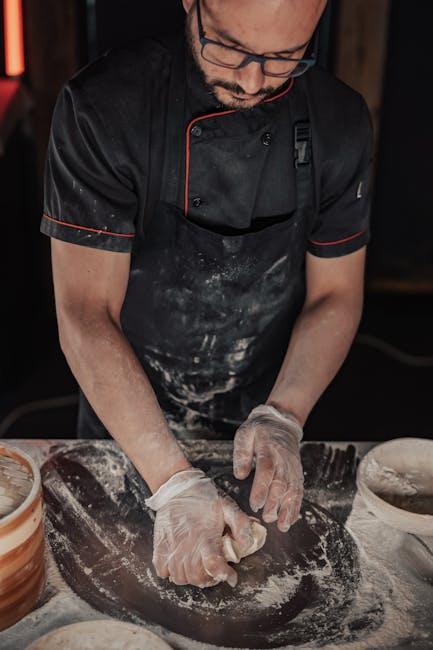Imagine walking into a kitchen filled with the sweet aroma of freshly baked goods, where the air is alive with anticipation and the promise of delicious treats. But wait—these aren’t just any baked goods. They’re crafted with care and creativity to be gluten-free, opening up a world of possibilities for those with dietary restrictions or simply seeking a healthier lifestyle. Welcome to the exciting realm of gluten-free baking, where every mix, measure, and knead is an opportunity to explore new flavors and textures. Whether you’re a curious novice or a seasoned cook stepping into this new frontier, we’re here to guide you with tips that will make your gluten-free baking journey not only successful but also delightful. So, roll up your sleeves, dust off your apron, and get ready to create mouthwatering masterpieces that everyone can enjoy. Let’s turn those gluten-free dreams into reality, one delicious bite at a time!
Mastering the Art of Gluten-Free Flour Blends
Creating your own gluten-free flour blends can be a game-changer in the kitchen, allowing you to customize textures and flavors to suit your baking dreams. The key to success lies in understanding the unique properties of each flour type. Rice flour provides a light texture, while almond flour adds richness and moisture. Tapioca starch brings elasticity, and potato starch enhances crispness. The beauty of these blends is their versatility, opening up a world of possibilities for cookies, breads, and pastries.
To get started, experiment with the following proportions for a versatile all-purpose mix:
- 1 cup of rice flour
- 1/2 cup of almond flour
- 1/4 cup of tapioca starch
- 1/4 cup of potato starch
Remember, practice makes perfect. Don’t be afraid to tweak the ratios to find what works best for your recipes. Keep your pantry stocked with a variety of gluten-free flours and have fun discovering new combinations that bring your baked goods to life!

Essential Ingredients for Delicious Gluten-Free Baking
Diving into the world of gluten-free baking can be both exciting and rewarding. It’s all about discovering the right ingredients that not only substitute but also elevate your baked goods to new levels of deliciousness. Almond flour, for instance, is a favorite among gluten-free enthusiasts, offering a nutty flavor and moist texture. It’s perfect for cakes and cookies that are rich and indulgent. Meanwhile, coconut flour brings a tropical twist with its sweet aroma and high fiber content, ideal for those who enjoy experimenting with flavor profiles.
- Xanthan Gum: This magical ingredient works as a binding agent, giving structure and elasticity to your doughs and batters.
- Arrowroot Powder: A superb thickener that is excellent for creating smooth sauces and custards without the gluten.
- Chia Seeds: When soaked, they form a gel-like consistency, perfect for egg-free baking.
- Gluten-Free Oats: A pantry staple that adds heartiness to muffins and breads, making them satisfying and nutritious.
Don’t forget to play around with tapioca starch and potato starch, as they both contribute to a lighter texture and help in achieving that coveted crumbly goodness. Remember, the secret to gluten-free baking lies in the balance and combination of these ingredients, so let your creativity run wild and enjoy the process!
Secrets to Perfectly Textured Gluten-Free Baked Goods
Creating gluten-free baked goods with that perfect texture is an art that can be mastered with a few strategic tips. Embrace the diversity of gluten-free flours—almond, coconut, rice, and sorghum flour each bring their own unique qualities to your recipes. Blending these flours can help achieve a balance that mimics the elasticity of gluten. Don’t shy away from experimenting with different combinations until you find your ideal mix.
- Hydration is key: Gluten-free flours tend to be more absorbent, so adjust your liquid ratios to maintain moisture.
- Bind it right: Use binders like xanthan gum or psyllium husk to add structure and prevent crumbling.
- Temperature matters: Baking at a slightly lower temperature can help ensure even cooking and a soft crumb.
Additionally, patience is a virtue when it comes to resting your dough. Allowing your batter to sit for 20-30 minutes before baking lets the flours fully hydrate and flavors meld beautifully. With a little practice and these handy tips, your gluten-free creations will not only taste amazing but also boast the perfect texture every time!
Troubleshooting Common Gluten-Free Baking Challenges
Embarking on the gluten-free baking journey can feel like a magical adventure, filled with unique challenges and delightful discoveries. Yet, even the most seasoned bakers can encounter a few bumps along the way. Fear not, brave bakers! Here are some simple solutions to common issues that may arise in your gluten-free kitchen.
- Crumbly Texture: If your baked goods tend to crumble, it might be time to embrace the power of binders. Ingredients like xanthan gum, psyllium husk, or chia seeds can add that much-needed elasticity to your dough, transforming your treats from crumbly to cohesive.
- Dense Results: For lighter, fluffier creations, consider using a mix of gluten-free flours. A combination of rice flour, potato starch, and tapioca flour can mimic the properties of wheat flour, resulting in a texture that’s just right.
- Off Flavors: If your baked goods have a strange aftertaste, it might be the flour blend. Try experimenting with different flour combinations or adding a splash of vanilla extract to balance the flavors.
Remember, each baking attempt is a step towards mastery. With patience and practice, you’ll be creating gluten-free delights that will amaze even the most discerning palates.



